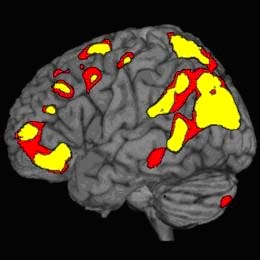Scientists find evidence for 'chronesthesia,' or mental time travel
December 22, 2010
 Researchers
have found evidence for "chronesthesia," which is the brain's
ability to be aware of the past and future, and to mentally travel in
subjective time. They found that activity in different brain regions
is related to chronesthetic states when a person thinks about the same
content during the past, present, or future.
Researchers
have found evidence for "chronesthesia," which is the brain's
ability to be aware of the past and future, and to mentally travel in
subjective time. They found that activity in different brain regions
is related to chronesthetic states when a person thinks about the same
content during the past, present, or future.
(PhysOrg.com) -- Scientists refer to the brain's ability to think about
the past, present, and future as "chronesthesia," or mental
time travel, although little is known about which parts of the brain
are responsible for these conscious experiences. In a new study, researchers
have used functional magnetic resonance imaging (fMRI) to investigate
the neural correlates of mental time travel and better understand the
nature of the mental time in which the metaphorical "travel"
occurs.
The researchers, Lars Nyberg from Umea University in Sweden; Reza Habib
from Southern Illinois University in Illinois; and Alice S. N. Kim,
Brian Levine, and Endel Tulving from the University of Toronto in Ontario,
have published their results in a recent issue of the Proceedings of
the National Academy of Sciences.
"Mental time travel consists of two independent sets of processes:
(1) those that determine the contents of any act of such 'travel': what
happens, who are the 'actors,' where does the action occur; it is similar
to the contents of watching a movie - everything that you see on the
screen; and (2) those that determine the subjective moment of time in
which the action takes place - past, present, or future," Tulving
told PhysOrg.com.
"In cognitive neuroscience, we know quite a bit about perceived,
remembered, known, and imagined space," he said. "We know
essentially nothing about perceived, remembered, known, and imagined
time. When you remember something that you did last night, you are consciously
aware not only that the event happened and that you were 'there,' as
an observer or participant, but also that it happened yesterday, that
is, at a time that is no more. The question we are asking is, how do
you know that it happened at a time other than 'now'?"
In their study, the researchers asked several well-trained subjects
to repeatedly think about taking a short walk in a familiar environment
in either the imagined past, the real past, the present, or the imagined
future. By keeping the content the same and changing only the mental
time in which it occurs, the researchers could identify which areas
of the brain are correlated with thinking about the same event at different
times.
The results showed that certain regions in the left lateral parietal
cortex, left frontal cortex, and cerebellum, as well as the thalamus,
were activated differently when the subjects thought about the past
and future compared with the present. Notably, brain activity was very
similar for thinking about all of the non-present times (the imagined
past, real past, and imagined future).Because
mental time is a product of the human brain and differs from the external
time that is measured by clocks and calendars, scientists also call
this time "subjective time." Chronesthesia, by definition,
is a form of consciousness that allows people to think about this subjective
time and to mentally travel in it.
Tulving said, "The concept of 'chronesthesia' is essentially brand
new. Therefore, I would say, the most important result of our study
is the novel finding that there seem to exist brain regions that are
more active in the (imagined) past and the (imagined) future than they
are in the (imagined) present. He added that, at this stage of the game,
it is too early to talk about potential implications or applications
of understanding how the brain thinks about the past, present, and future.
"Our study, we hope, is the first swallow of the spring, and others
will follow," he said.
Excerpt
from www.PhysOrg.com